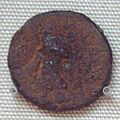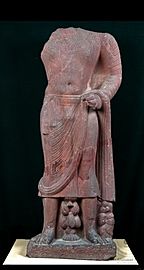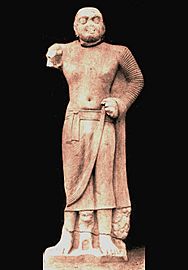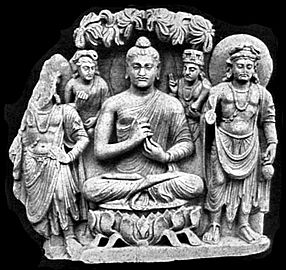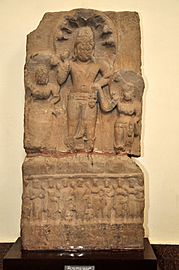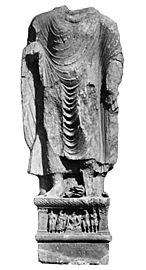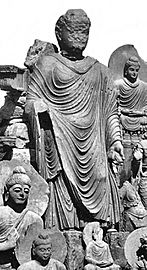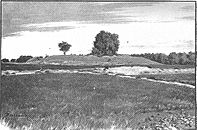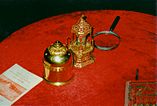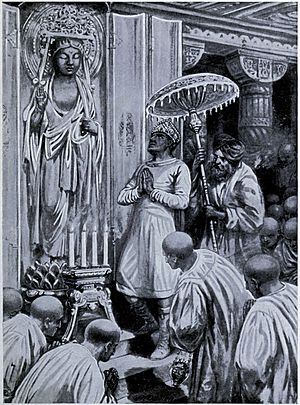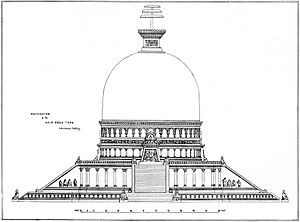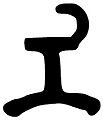Kanishka facts for kids
Quick facts for kids Kanishka I |
|
|---|---|
| King of Kings (Bactrian: Shaonanoshao) |
|
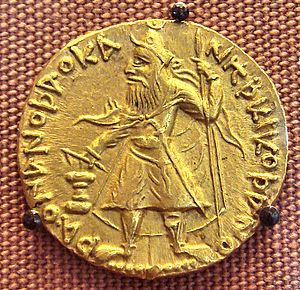
ϷΑΟΝΑΝΟϷΑΟ ΚΑΝΗϷΚΙ ΚΟϷΑΝΟ Shaonanoshao Kanishki Koshano "King of Kings, Kanishka the Kushan". British Museum. |
|
| Reign | 2nd century (120-144) |
| Predecessor | Vima Kadphises |
| Successor | Huvishka |
| Born | Bactria/Central Asia |
| Died | Central Asia/India |
| House | Kushan Shahs |
| Dynasty | Kushan |
| Religion | Buddhism |
Kanishka I (also known as Kanishka the Great) was a powerful emperor of the Kushan Empire in the 2nd century CE (around 127–150 CE). He is famous for his achievements in war, politics, and religion. Kanishka was a descendant of Kujula Kadphises, who founded the Kushan Empire.
Under Kanishka, the empire stretched from Bactria (in Central Asia) all the way to Pataliputra in India. The main capital of his empire was in Puruṣapura (modern-day Peshawar), with another important capital at ancient Kapisa.
Kanishka's military victories and his support for Buddhism were very important. They helped the famous Silk Road trade route grow. They also helped spread a type of Buddhism called Mahayana Buddhism from Gandhara (an ancient region) to China. Around 127 CE, he made Bactrian the official language of his empire, replacing Greek.
Historians used to think Kanishka became king in 78 CE, and that this date started the Saka era calendar. However, most historians now believe he started his rule around 127 CE.
Contents
Who Was Kanishka?
Mahārāja Rājadhirāja Devaputra Kāṇiṣka
"The Great King, King of Kings, Son of God, Kanishka".
From Mathura art, Mathura Museum
Kanishka was a Kushan ruler, likely from the Yuezhi people. We don't know what his first language was. An important ancient text, the Rabatak inscription, was written in a Greek script. It used a language called Arya, which was probably a form of Bactrian. This language was likely used by the Kushans to talk with the people they ruled.
The Rabatak inscription also tells us about Kanishka's family. It shows that Kanishka was the successor of Vima Kadphises. The inscription lists the kings who ruled before him: Kujula Kadphises was his great-grandfather, Vima Taktu was his grandfather, and Vima Kadphises was his father.
Kanishka's Empire and Conquests
Kanishka's empire was very large. It stretched from parts of Uzbekistan and Tajikistan in the northwest to Northern India. It reached as far as Mathura in the southeast. The Rabatak inscription even says he controlled Pataliputra and Sri Champa. His empire also included Kashmir, where a town called Kanishkapur (modern Kanispora) was named after him.
His control over Central Asia is less clear. An ancient Chinese book, the Hou Hanshu, mentions that a Chinese general named Ban Chao fought a Kushan army in 90 AD. This battle happened near Khotan. Ban Chao claimed victory, forcing the Kushans to retreat. The areas of Kashgar, Khotan, and Yarkand in the Tarim Basin (modern Xinjiang) were under Chinese control. However, some of Kanishka's coins have been found in the Tarim Basin.
One of Kanishka's main goals was to control the trade routes. This included both the land route (the Silk Road) and the sea routes between South Asia and the Roman Empire.
-
Kushan territories (solid line) and the largest extent of Kanishka's empire (dotted line), according to the Rabatak inscription.
-
A bronze coin of Kanishka, found in Khotan, modern China.
Kanishka's Coins
Kanishka's coins show images of gods from different religions. These include gods from India, Greece, Iran, and even ancient Sumer and Elam. This mix of gods shows that Kanishka's beliefs were a blend of different traditions, a concept called religious syncretism.
Early coins from his reign had Greek writing and showed Greek gods. Later coins used the Bactrian language, which was the Iranian language spoken by the Kushans. On these later coins, Greek gods were replaced by similar Iranian ones. All of Kanishka's coins, even those in Bactrian, used a changed Greek alphabet. This alphabet had an extra letter (Ϸ) for the "sh" sound, like in "Kushan" and "Kanishka."
On his coins, Kanishka is usually shown as a bearded man wearing a long coat and trousers. Flames often appear from his shoulders, showing his power. He wears large boots and carries a long sword and a spear. He is often shown making an offering at a small altar.
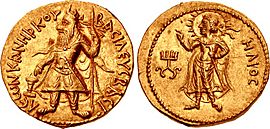
Front: Kanishka standing in a heavy Kushan coat and long boots. Flames come from his shoulders. He holds a standard and makes an offering at an altar. Greek writing says: "coin of Kanishka, king of kings."
Back: The Greek sun god Helios standing in a Greek style, making a blessing gesture. The writing says: "Helios". Kanishka's symbol (tamgha) is on the left.
Some of the gods shown on his coins include:
- Iranian gods: Ardoxsho (goddess of wealth), Pharro (glory), Mao (moon god), Mithro (sun god), Nana (a powerful goddess), Oado (wind god), and Orlagno (god of victory).
- Buddhist gods: Boddo (the Buddha), Shakyamuni Boddo (another name for the Buddha), and Metrago Boddo (the bodhisattva Maitreya).
- Hindu gods: Oesho (the god Shiva).
Kanishka and Buddhism
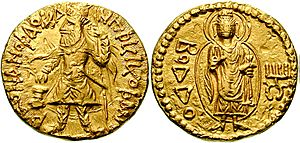
Front: Kanishka standing in a heavy Kushan coat and long boots. Flames come from his shoulders. He holds a standard and makes an offering at an altar. Kushan writing in Greek script says: "King of Kings, Kanishka the Kushan."
Back: The Buddha standing in a Greek style. He makes a gesture of "no fear" (abhaya mudra) with his right hand and holds his robe with his left. The writing says: "Boddo" for the Buddha. Kanishka's symbol is on the right.
Kanishka is very important in Buddhist history because he not only believed in Buddhism but also strongly supported its teachings. He led the 4th Buddhist Council in Kashmir, which was a major meeting of Buddhist scholars. During his time, images of the Buddha were created based on traditional descriptions.
He supported both the Gandhara school of art and the Mathura school of art. Kanishka seemed to like both Buddhism and Persian traditions, but he favored Buddhism more. This is shown by his dedication to Buddhist teachings and prayers, as described in various books about the Kushan Empire.
His biggest contribution to Buddhist architecture was the Kanishka stupa in Purushapura (modern-day Peshawar). Archaeologists found the base of this stupa in 1908–1909. It was 286 feet (87 meters) wide. Chinese travelers like Xuanzang reported that it was 600 to 700 Chinese "feet" tall (about 180–210 meters or 591–689 ft.) and covered with jewels. This huge building was considered one of the wonders of the ancient world.
Kanishka was said to be very close to the Buddhist scholar Ashvaghosha, who became his religious advisor later in his life.
Buddhist Coins
Kanishka's Buddhist coins are quite rare. Many of them show Kanishka on one side and the Buddha standing on the other. Some also show the Shakyamuni Buddha and Maitreya. The images on these coins are often a bit rough, with large ears and feet spread apart, similar to how the Kushan king is shown.
There are three main types of Kanishka's Buddhist coins:
Standing Buddha
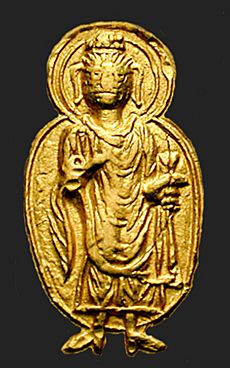
Only six gold coins of the Buddha from the Kushan period are known. They were all made under Kanishka I. These coins come in two sizes: a large one (about 8 grams) and a smaller one (about 2 grams).
The Buddha is shown wearing monastic robes that cover both shoulders. His ears are very large and long, which might have been a way to make them clear on small coins. He has a large topknot covering his usnisha (a bump on the head, a sign of wisdom). He also has a mustache. The palm of his right hand has the Chakra mark, and his brow has the urna (a dot between the eyebrows). A aureola (halo) surrounds his head.
The way the Buddha's robe covers both shoulders suggests that the images were based on statues from the Gandhara region.
"Shakyamuni Buddha"
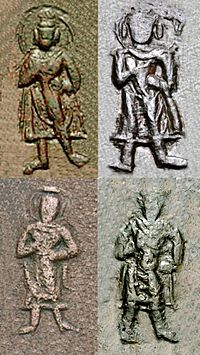
These coins show the Shakyamuni Buddha (another name for the historical Buddha, Siddharta Gautama). He stands facing forward, with his left hand on his hip and his right hand making the "no fear" gesture (abhaya mudra). These coins are only found in copper and are usually quite worn.
The Buddha's robe on these coins is very light, almost transparent, showing the body's outline. His robe is folded over his left arm. He has a large topknot covering his ushnisha and a simple or double halo around his head.
"Maitreya Buddha"
These coins show the Bodhisattva Maitreya (the Buddha of the future). He sits cross-legged on a throne, holding a water pot, and also making the Abhaya mudra. These coins are only found in copper and are usually very worn.
On the clearest coins, Maitreya appears to wear armbands like an Indian prince. The throne is decorated with small columns, suggesting that the coin image was copied from existing statues. It's important to note that Maitreya is a Bodhisattva, not yet a Buddha.
The way the Buddhas are shown on these coins (facing forward) is different from how other gods are shown (from the side). This suggests that the Buddha images were copied from statues that were also shown facing forward. The robes covering both shoulders indicate that the statues used as models were from the Gandhara school of art, not Mathura.
Buddhist Statues from Kanishka's Time
Several Buddhist statues are directly linked to Kanishka's rule. For example, some Bodhisattva statues from the Art of Mathura have inscriptions dating them to his reign. Other statues from Gandhara are dated to an era now believed to be the Yavana era, starting between 186 and 175 BCE.
| Dated Statues from Kanishka's Reign | |
|
|
Kanishka Stupa and Casket
The "Kanishka casket" or "Kanishka reliquary" was found in 1908–1909. It was in a hidden chamber under the Kanishka stupa in Shah-Ji-Ki-Dheri, near Peshawar. Today, it is in the Peshawar Museum, and a copy is in the British Museum. It is believed to have held three bone fragments of the Buddha, which are now in Mandalay, Burma.
The casket has an inscription in Kharoshthi script. It mentions Kanishka and the building of the stupa. The text is signed by the artist, a Greek man named Agesilas. This shows that Greeks were directly involved in Buddhist art even at this later time.
The lid of the casket shows the Buddha on a lotus flower, being worshipped by the gods Brahma and Indra. The edge of the lid has a design of flying geese. The main part of the casket shows a Kushan king, probably Kanishka himself, with the Iranian sun and moon gods beside him. On the sides are two images of a seated Buddha, worshipped by royal figures, possibly Kanishka. A decorative garland, held by cherubs, goes around the scene in a Greek style.
Some experts have recently questioned if the casket really belongs to Kanishka. This is because the ruler shown on the casket does not have a beard, unlike Kanishka. Instead, some believe the casket belongs to Kanishka's successor, Huvishka.
Kanishka in Buddhist Stories
In Buddhist stories, Kanishka is often described as a strong and sometimes harsh king before he became a Buddhist. After he converted, he became a kind, generous, and faithful ruler. One story from the Sri-dharma-pitaka-nidana sutra says: "At this time the King of Ngan-si (Pahlava) was very aggressive and had a violent nature....A Buddhist monk (bhikshu arhat) saw the king's harsh actions and wanted him to change. So, using his special powers, he made the king see the suffering of hell. The king was terrified and changed his ways. He cried and got rid of all his negative feelings, becoming self-aware for the first time."
Stories also say that the Buddha himself predicted Kanishka's arrival and the building of his stupa: ". . . the Buddha, pointing to a small boy making a mud tope....[said] that on that spot Kaṇiṣka would build a tope (stupa) named after him." Vinaya sutra
A scroll found in Dunhuang also tells a similar story. It says Kanishka would arrive 400 years after the Buddha's death. The story also describes how Kanishka built his stupa: "A wish grew in [Kanishka to build a huge stupa]....At that time, the four world-regents learned the king's thoughts. So, for his sake, they took the form of young boys....[and] began a stupa of mud....the boys said to [Kanishka] 'We are making the Kaṇiṣka-stūpa.'....Then the boys changed their form....[and] said to him, 'Great king, according to the Buddha's prophecy, you must build a monastery (Saṅghārāma) with a large stupa. Relics must be brought here by good beings.'"
Chinese travelers to India, like Xuanzang, who visited around 630 CE, also shared this story: "Kaṇiṣka became the ruler of all Jambudvīpa (Indian subcontinent). He did not believe in Karma at first, but he treated Buddhism with honor and respect after he converted. He was interested in its teachings. While hunting, a white hare appeared. The king chased it, and the hare suddenly disappeared at [the site of the future stupa]....[When the stupa construction wasn't going well] the king became impatient and took charge. He completed the stupas perfectly. These two stupas still exist and people visit them for healing." King Kanishka was highly respected by his people because of his kindness, humility, and fairness. He was seen as "THE KING OF KINGS."
Buddhism Spreads to China
Buddhist monks from the Gandhara region were very important in spreading Buddhist ideas to northern Asia starting in the mid-2nd century CE. A Kushan monk named Lokaksema (around 178 CE) was the first to translate important Buddhist texts into Chinese. He set up a translation center in the Chinese capital, Loyang. Buddhist monks from Central Asia and East Asia continued to share ideas for many centuries.
Kanishka was likely followed by Huvishka as emperor. How and when this happened is not fully clear. Kanishka was the only king with that name in the Kushan dynasty. An inscription on The Sacred Rock of Hunza also shows signs of Kanishka.
Images for kids
See also
 In Spanish: Kanishka para niños
In Spanish: Kanishka para niños





